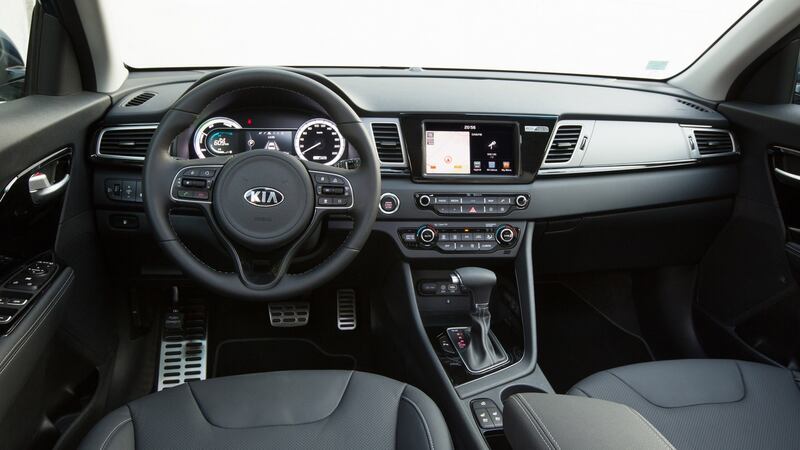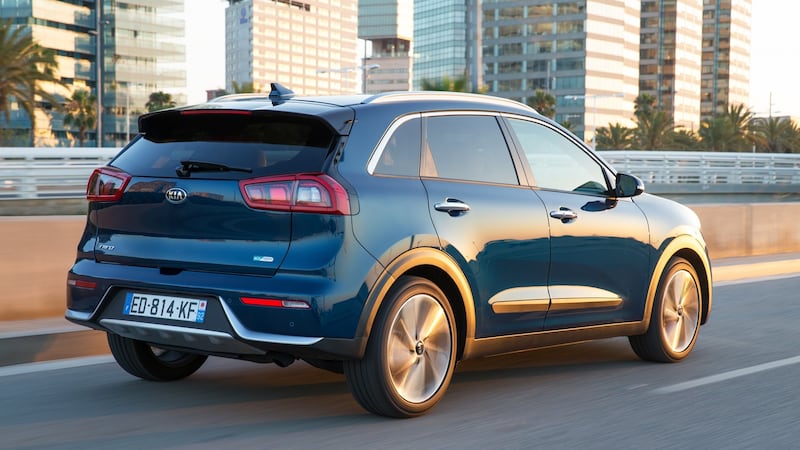Carmakers are under increasing demands to reduce exhaust emissions. It's hard to see what further CO2 reductions can be squeezed out of the ageing internal combustion engine without totally strangling the power output. The quick road to cutting emissions is to use hybrid power. The new Niro range from Kia – and its sister brand Hyundai's Ioniq range – has been designed as a low-emissions hybrid from the ground up.
Built on a unique platform, it slots in between the Kia Sportage SUV and Kia Cee’d family hatchback in terms of size. With a low 88g km/CO2 figure it is far greener than both and will help the Korean carmaker move in the right direction.
We went to the outskirts of Barcelona to test the car, which was first revealed at the Geneva motor show. Niro is a five-seat, front-wheel-drive hatchback styled in the US and Korea. It sits on quite a wide track that physically shifts it away from the narrower Cee’d. In fact it looks more like a lowered Sportage.


Niro is clearly recognisable as a Kia with its tiger nose grille. There are some nice new touches such as the front-wheel air curtain in the bumper and subtle metal creases in the bonnet and flanks.
The exterior looks sturdy and solid even though it weighs in at just under 1.5 tonnes. Niro’s bonnet and tailgate are made from lightweight aluminium. It has nice alloys and a sleek rear spoiler, but otherwise it is pretty conservative and at best is easy on the eye.
The 4,355mm long car is relatively aerodynamic for a crossover with a cd of 0.29. Niro is marginally shorter than Sportage, but inside the cabin feels as big thanks to its 2,700mm wheelbase. That wheelbase combined with its wide track gives Niro a planted feel on the road.
It has sophisticated dual- arm, multi-link rear suspension and classic McPherson struts up front. The steering is geared well, but offers little in the way of feel or feedback.
Relaxing
Niro is not an enthusiast’s car, but it does what you ask of it well and is easy to use. Even on fast twisting roads, when we enthusiastically challenged the car’s suspension, Niro coped well. It’s no GTI but it makes adequate progress, with a 0-100kph time of 11.5 seconds, and its initial get up and go is impressive. It will cruise happily at motorway speeds too.
Inside there is a good deal of standard equipment. Irish cars will get leather seats, sat-nav with good smartphone connectivity, dual air conditioning, privacy glass, lane departure warning, rain-sensing wipers and LED front and rear lights as standard.
For a yet to be finalised premium, buyers can get an “extra safety” version. This Niro includes autonomous emergency city braking and smart cruise control. In this guise Niro attains the new and stricter Five Star Euro NCAP rating – the standard Niro gets a Four Star rating.
Kia’s Autonomous emergency braking can recognise not only cars but pedestrians too. Using radar and a windscreen- mounted camera, the car identifies people from 80cm in height upwards. On a controlled rooftop car-park testing area we drove directly at a mannequin with our foot on the throttle.
The car sequentially made an audible collision alert, then applied half braking power followed by full braking. The Niro stopped short of colliding with the plastic form without any intervention from me. Most carmakers with similar systems don’t claim to be effective with pedestrians . . . although many are. Kia also lists among Niro’s available driving aids lane-keeping assist, blind-spot detection and rear cross traffic alert – that is very handy when reversing out of a parking space.
Pleasant place
Great attention has been given to keeping noise, vibration and harshness levels low and the cabin is a pleasant place. The entry car rides on low-rolling resistance tyres fitted to aerodynamic wheels. The next model up rides on 18-inch alloys that increase CO2 emissions to 101g, but they deliver a sportier drive. There is lots of headroom front and rear and the leather seats are comfortable. Boot space is a respectable 427 litres and includes an underfloor emergency spare wheel. Fold the seats and there is up to 1,425 litres of cargo space. Niro can be fitted with a tow bar and is certified to haul up to 1,300kgs using a braked trailer. This is something hybrids generally can’t, or are not certified to, do.
Power comes from the familiar Kappa GDI four-cylinder 1.6 litre direct-injection petrol engine and a 32kW electric motor powered by a 1.56kWh lithium-ion polymer battery pack that is located under the rear bench. The combined power output is 141hp and 264nm – which is available in first gear. The battery pack weighs a modest 33kgs. The fuel tank holds 45 litres. Niro features an exhaust heat recovery system that reduces emissions and improves overall efficiency.
The 6DCT gearbox is a six- speed optimised double-clutch unit that helps deliver a claimed combined fuel consumption figure of 3.8l/100km on the standard 16-inch alloys. The car can be left in auto or manually shifted via the lever when manual sports mode is selected. There are no paddle shifters or a regenerative braking option as found in Toyota hybrids.
There is no EV mode switch either, so you have no specific control over when electric-only drive kicks in. Niro has a transmission-mounted electric device called TMED that allows the engine and electric motor’s power to be delivered in parallel through the gearbox with minimum loss of energy.
Kia says Niro’s parallel hybrid power delivery is better than the power split systems commonly used with e-CVT gearboxes and delivers a more instant response to the throttle. Niro’s gearbox acts and feels like a modern automatic.
In Europe Kia’s connected services will be free, on cars fitted with the TomTom navigation option, for the first seven years of the car’s life.
Connectivity is good, with Android Auto and Apple CarPlay offered. Wireless phone charging is available as an option too, but again we will have to wait for more details and pricing from Kia Ireland.
Sales doubled
Michael Cole
, chief operating officer, Kia Europe, says: “Hybrid sales have more than doubled in Europe over the last five years, and are forecast to account for around 700,000 sales in Europe by 2020. The Niro will allow Kia to meet this growing demand for alternatively-fuelled vehicles, and help us meet our 2020 global target to improve average fleet fuel efficiency by 25 per cent over 2014 levels.”
We understand from senior Kia management that Niro represents the start of greater autonomy from its dominate partner Hyundai – especially with niche machines such as Niro. Synergies will continue to be exploited with volume models, but Kia is going to be allowed to use its own crayons so to speak more often going forward.
Kia Niro goes on sale in mid-October. Ireland prices start from €28,995 net of the €1,500 government grant. In a full year Kia Ireland expects to sell about 200.











